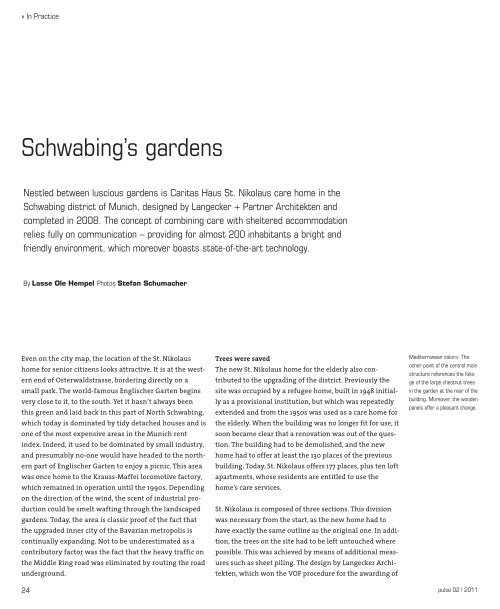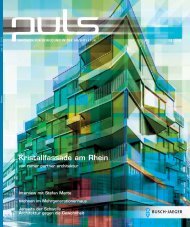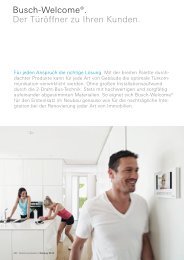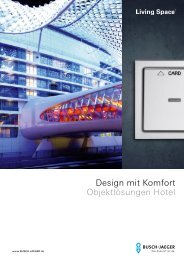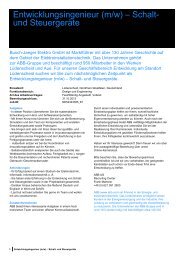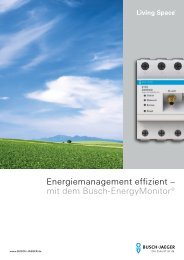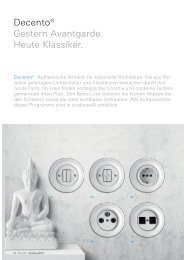+49 (0)1805-66 99 09 Email: pulse@de.abb.com - Busch-Jaeger ...
+49 (0)1805-66 99 09 Email: pulse@de.abb.com - Busch-Jaeger ...
+49 (0)1805-66 99 09 Email: pulse@de.abb.com - Busch-Jaeger ...
You also want an ePaper? Increase the reach of your titles
YUMPU automatically turns print PDFs into web optimized ePapers that Google loves.
» In Practice<br />
Schwabing’s gardens<br />
Nestled between luscious gardens is Caritas Haus St. Nikolaus care home in the<br />
Schwabing district of Munich, designed by Langecker + Partner Architekten and<br />
<strong>com</strong>pleted in 2008. The concept of <strong>com</strong>bining care with sheltered ac<strong>com</strong>modation<br />
relies fully on <strong>com</strong>munication – providing for almost 200 inhabitants a bright and<br />
friendly environment, which moreover boasts state-of-the-art technology.<br />
By Lasse Ole Hempel Photos Stefan Schumacher<br />
Even on the city map, the location of the St. Nikolaus<br />
home for senior citizens looks attractive. It is at the western<br />
end of Osterwaldstrasse, bordering directly on a<br />
small park. The world-famous Englischer Garten begins<br />
very close to it, to the south. Yet it hasn’t always been<br />
this green and laid back in this part of North Schwabing,<br />
which today is dominated by tidy detached houses and is<br />
one of the most expensive areas in the Munich rent<br />
index. Indeed, it used to be dominated by small industry,<br />
and presumably no-one would have headed to the northern<br />
part of Englischer Garten to enjoy a picnic. This area<br />
was once home to the Krauss-Maffei lo<strong>com</strong>otive factory,<br />
which remained in operation until the 1<strong>99</strong>0s. Depending<br />
on the direction of the wind, the scent of industrial production<br />
could be smelt wafting through the landscaped<br />
gardens. Today, the area is classic proof of the fact that<br />
the upgraded inner city of the Bavarian metropolis is<br />
continually expanding. Not to be underestimated as a<br />
contributory factor was the fact that the heavy traffic on<br />
the Middle Ring road was eliminated by routing the road<br />
underground.<br />
24<br />
Trees were saved<br />
The new St. Nikolaus home for the elderly also contributed<br />
to the upgrading of the district. Previously the<br />
site was occupied by a refugee home, built in 1948 initially<br />
as a provisional institution, but which was repeatedly<br />
extended and from the 1950s was used as a care home for<br />
the elderly. When the building was no longer fit for use, it<br />
soon became clear that a renovation was out of the question.<br />
The building had to be demolished, and the new<br />
home had to offer at least the 130 places of the previous<br />
building. Today, St. Nikolaus offers 177 places, plus ten loft<br />
apartments, whose residents are entitled to use the<br />
home’s care services.<br />
St. Nikolaus is <strong>com</strong>posed of three sections. This division<br />
was necessary from the start, as the new home had to<br />
have exactly the same outline as the original one. In addition,<br />
the trees on the site had to be left untouched where<br />
possible. This was achieved by means of additional measures<br />
such as sheet piling. The design by Langecker Architekten,<br />
which won the VOF procedure for the awarding of<br />
Mediterranean colors: The<br />
ocher paint of the central main<br />
structure references the foliage<br />
of the large chestnut trees<br />
in the garden at the rear of the<br />
building. Moreover, the wooden<br />
panels offer a pleasant change.<br />
pulse 02 | 2011


